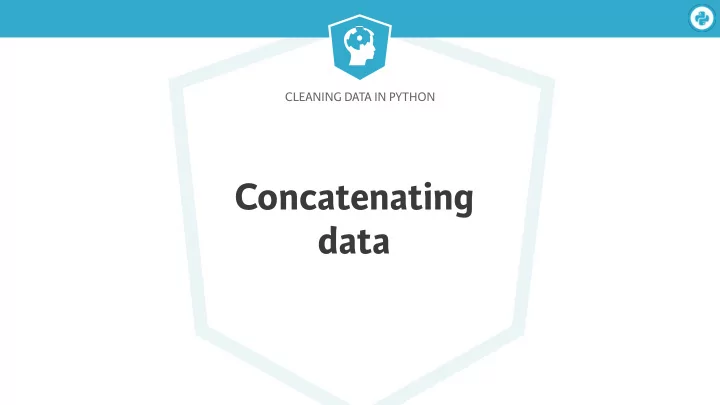

CLEANING DATA IN PYTHON Concatenating data
Cleaning Data in Python Combining data ● Data may not always come in 1 huge file ● 5 million row dataset may be broken into 5 separate datasets ● Easier to store and share ● May have new data for each day ● Important to be able to combine then clean, or vice versa
Cleaning Data in Python Concatenation
Cleaning Data in Python pandas concat In [1]: concatenated = pd.concat([weather_p1, weather_p2]) In [2]: print(concatenated) date element value 0 2010-01-30 tmax 27.8 1 2010-01-30 tmin 14.5 0 2010-02-02 tmax 27.3 1 2010-02-02 tmin 14.4
Cleaning Data in Python pandas concat In [3]: concatenated = concatenated.loc[0, :] Out[3]: date element value 0 2010-01-30 tmax 27.8 0 2010-02-02 tmax 27.3
Cleaning Data in Python pandas concat In [4]: pd.concat([weather_p1, weather_p2], ignore_index=True) Out[4]: date element value 0 2010-01-30 tmax 27.8 1 2010-01-30 tmin 14.5 2 2010-02-02 tmax 27.3 3 2010-02-02 tmin 14.4
Cleaning Data in Python Concatenating DataFrames
CLEANING DATA IN PYTHON Let’s practice!
CLEANING DATA IN PYTHON Finding and concatenating data
Cleaning Data in Python Concatenating many files ● Leverage Python’s features with data cleaning in pandas ● In order to concatenate DataFrames: ● They must be in a list ● Can individually load if there are a few datasets ● But what if there are thousands? ● Solution: glob function to find files based on a pa � ern
Cleaning Data in Python Globbing ● Pa � ern matching for file names ● Wildcards: * ? ● Any csv file: *.csv ● Any single character: file_?.csv ● Returns a list of file names ● Can use this list to load into separate DataFrames
Cleaning Data in Python The plan ● Load files from globbing into pandas ● Add the DataFrames into a list ● Concatenate multiple datasets at once
Cleaning Data in Python Find and concatenate In [1]: import glob In [2]: csv_files = glob.glob('*.csv') In [3]: print(csv_files) ['file5.csv', 'file2.csv', 'file3.csv', 'file1.csv', 'file4.csv']
Cleaning Data in Python Using loops In [4]: list_data = [] In [5]: for filename in csv_files: ...: data = pd.read_csv(filename) ...: list_data.append(data) In [6]: pd.concat(list_data)
CLEANING DATA IN PYTHON Let’s practice!
CLEANING DATA IN PYTHON Merge data
Cleaning Data in Python Combining data ● Concatenation is not the only way data can be combined
Cleaning Data in Python Merging data ● Similar to joining tables in SQL ● Combine disparate datasets based on common columns
Cleaning Data in Python Merging data In [1]: pd.merge(left=state_populations, right=state_codes, ...: on=None, left_on='state', right_on='name') Out[1]: state population_2016 name ANSI 0 California 39250017 California CA 1 Texas 27862596 Texas TX 2 Florida 20612439 Florida FL 3 New York 19745289 New York NY
Cleaning Data in Python Types of merges ● One-to-one ● Many-to-one / one-to-many ● Many-to-many
Cleaning Data in Python One-to-one
Cleaning Data in Python One-to-one
Cleaning Data in Python Many-to-one / one-to-many
Cleaning Data in Python Many-to-one / one-to-many
Cleaning Data in Python Di ff erent types of merges ● One-to-one ● Many-to-one ● Many-to-many ● All use the same function ● Only di ff erence is the DataFrames you are merging
CLEANING DATA IN PYTHON Let’s practice!
Recommend
More recommend